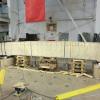Description
Current U.S. design provisions for lap splices of deformed bars in tension were developed primarily from tests conducted on beams with lap lengths not exceeding 40 bar diameters. But the provisions often require splices to be longer than 40 bar diameters. Recent structural failures have indicated the vulnerability of lap splices with length-to-bar-diameter ratios equal to or exceeding 40. In this study, the tensile strength of unconfined deformed-bar lap splices with different lengths is reexamined. The focus is on lap splices with length-to-bar-diameter ratios of 40 or more. The tensile strength of lap splices in configurations resembling those observed to have splice failures in the field is also examined.
Three series of tests (with a total of forty-five specimens) were conducted on specimens with lap lengths varying from 20 to 85 bar diameters. In series one, twenty-seven prismatic coupons were tested monotonically to failure in tension. In the second and third series, a total of eighteen beams were tested to failure. The beam lap splices were located in a region of constant moment.
The results in this study indicated that increasing the length of a lap splice beyond 45 bar diameters was an inefficient way to increase the strength of the splice. The results also indicated that a mean unit bond strength of 5√f'c (in psi) is not a lower bound, as suggested by current design provisions, to the strength of unconfined deformed-bar lap splices with a minimum clear cover of 1 bar diameter and a minimum clear spacing between bars of 2 bar diameters.
To address these issues, a new perspective on the tensile strength of unconfined lap splices is explored. It is suggested that, rather than setting a lower bound to the mean unit bond strength for design, an upper bound of 900√f'c (in psi) should be set for the maximum steel stress that can be developed in unconfined deformed-bar lap splices
Cite this work
Researchers should cite this work as follows:
- Richter, B.; Pujol, S. (2017). A New Perspective on the Tensile Strength of Lap Splices in Reinforced Concrete Members. Purdue University Research Repository. doi:10.4231/R7GB2275
Tags
Notes
This dataset was compiled on 2015-03-20 by Brian Richter, Aishwarya Puranam, Chungwook Sim, Santiago Pujol and originally created in the datacenterhub. Its original location is at https://datacenterhub.org/resources/140. This dataset was imported to PURR for preservation and long-term access in summer 2017.
